#seymour duncan pickups
Explore tagged Tumblr posts
Text
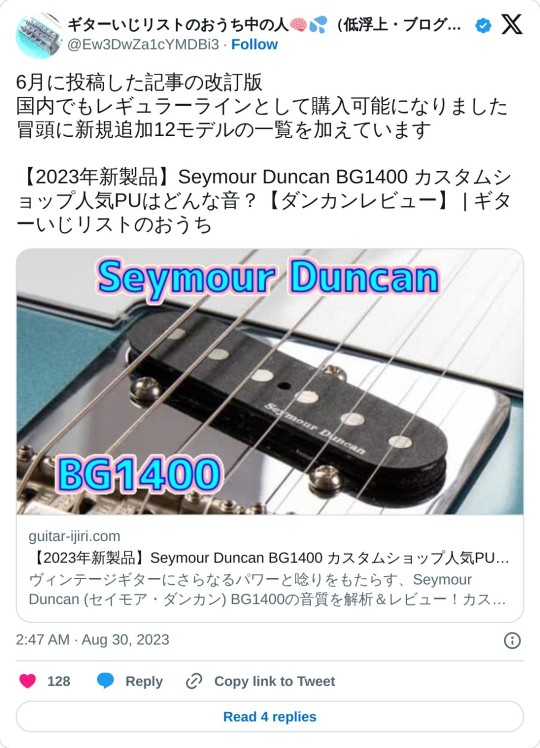
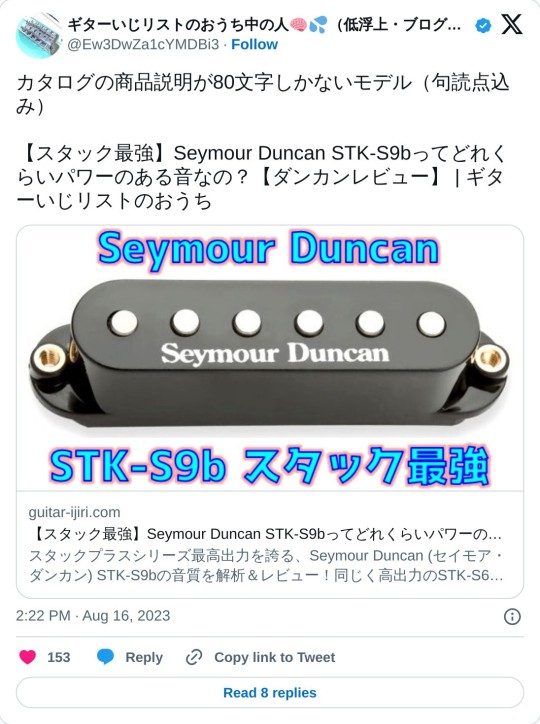
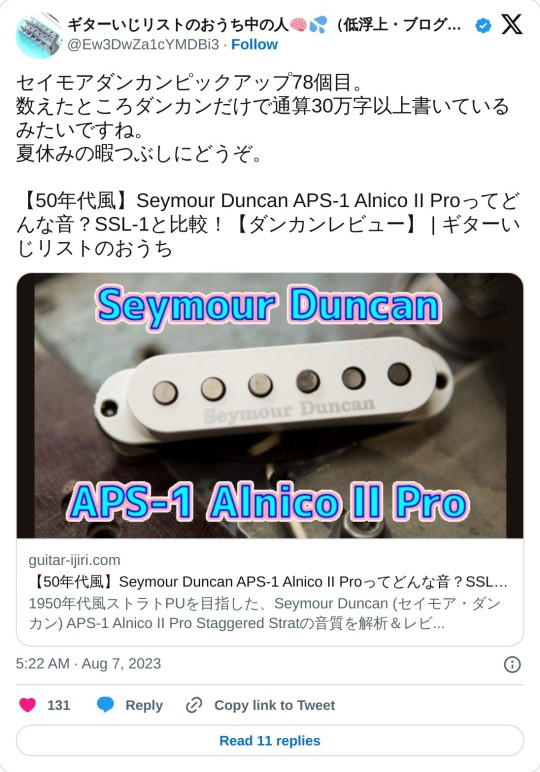
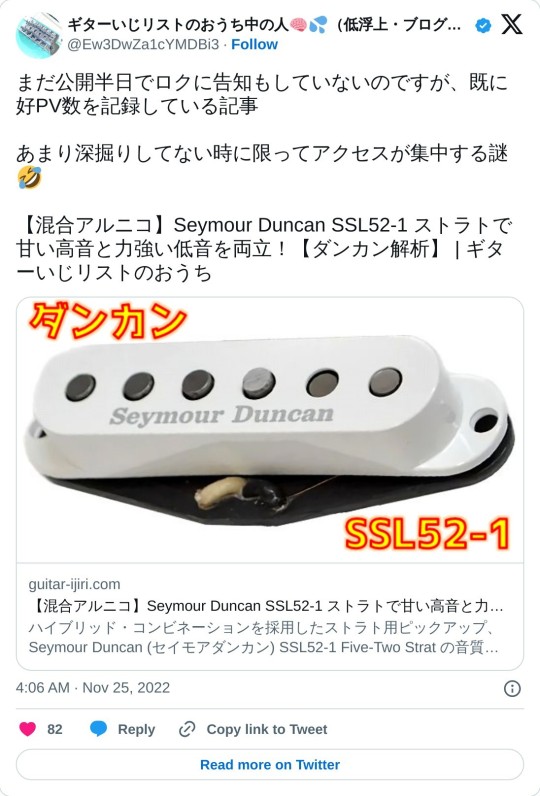
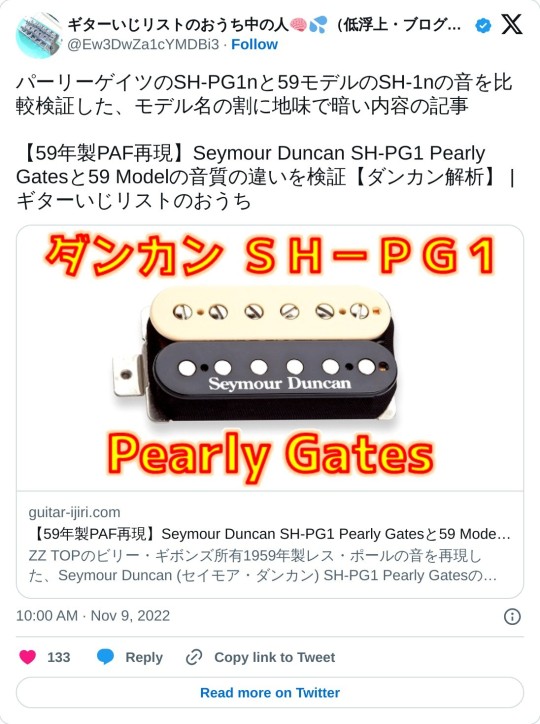
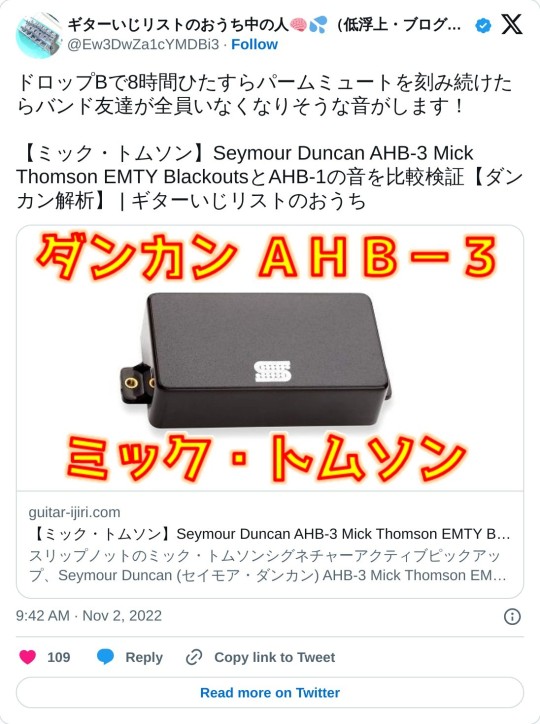

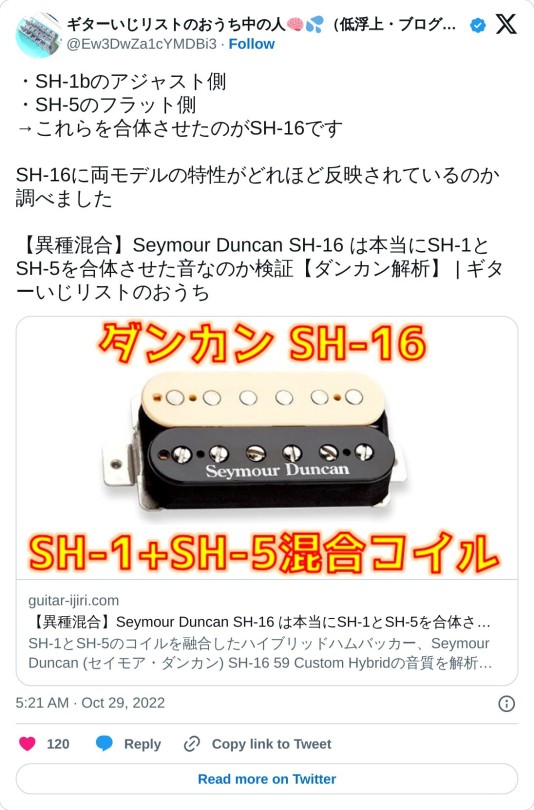
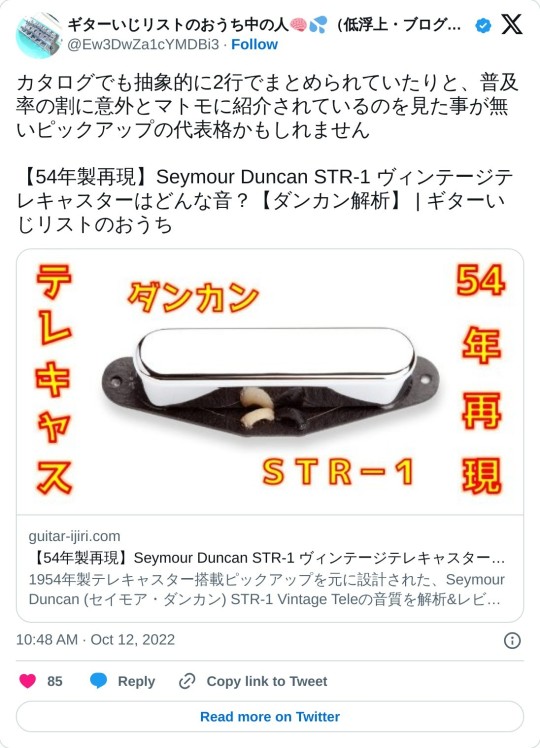

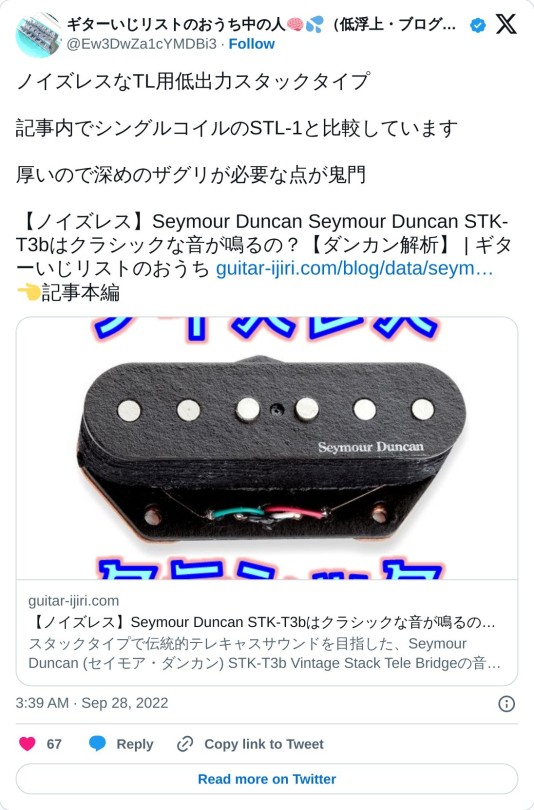


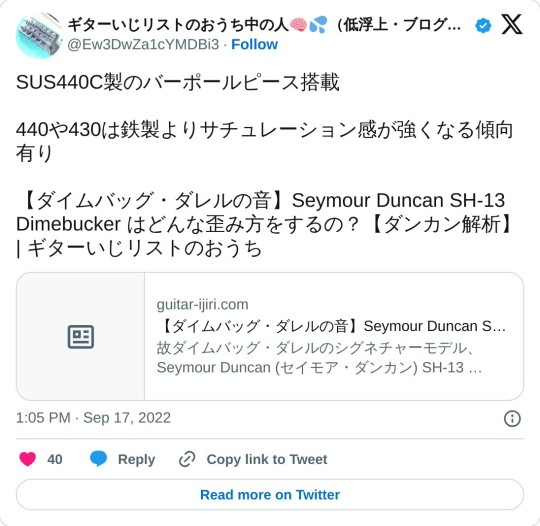
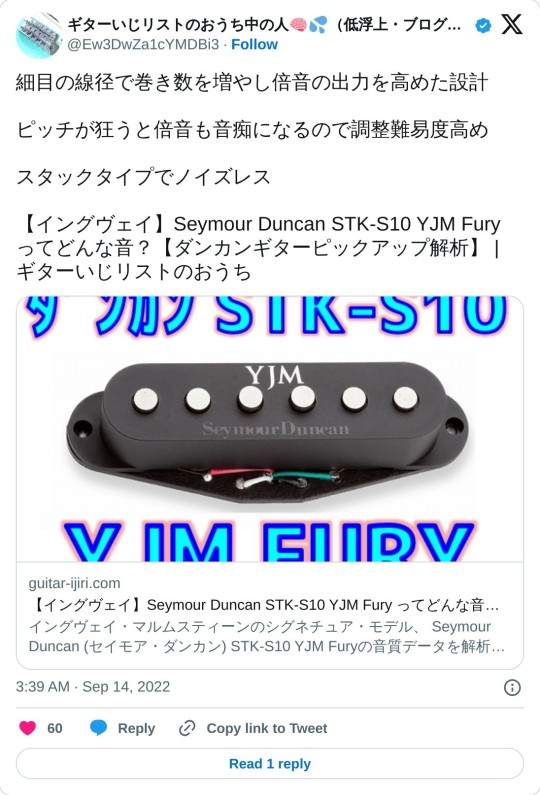
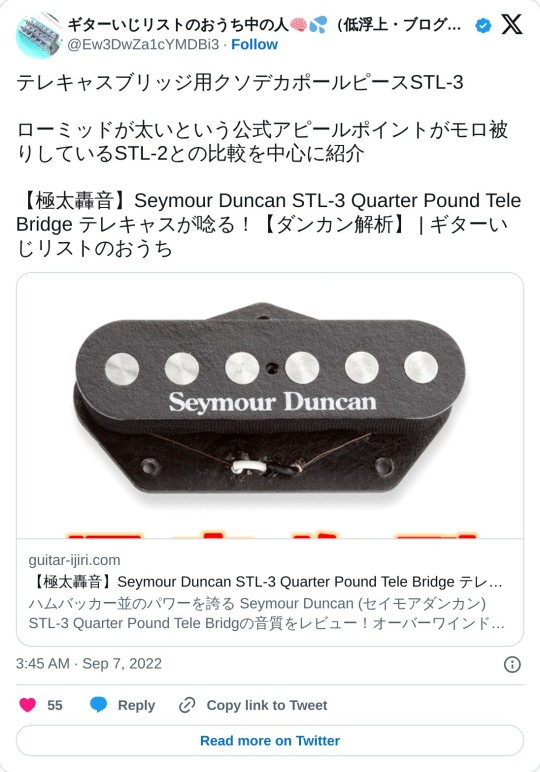







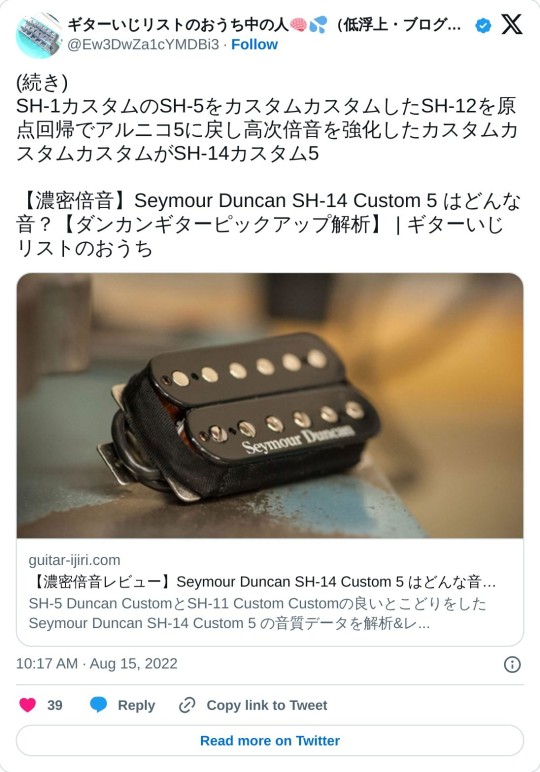
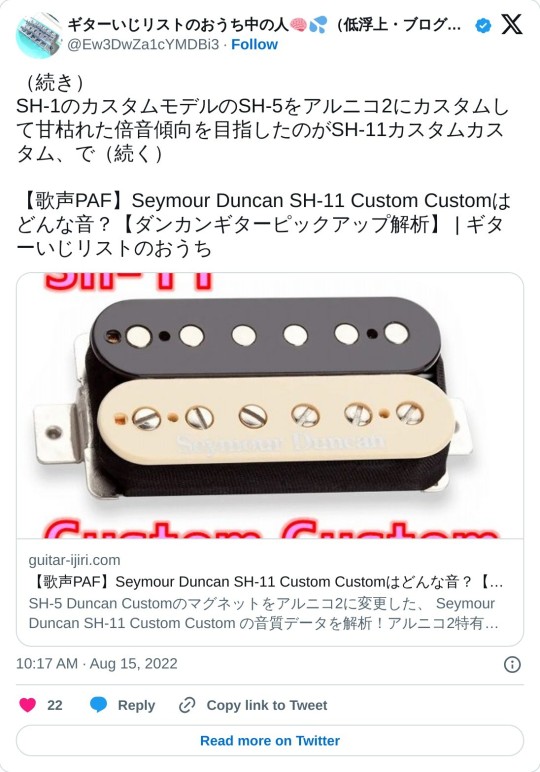
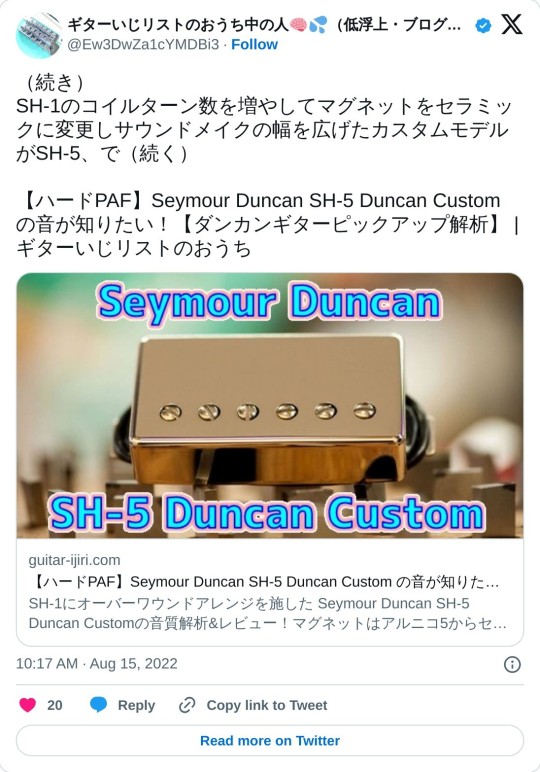
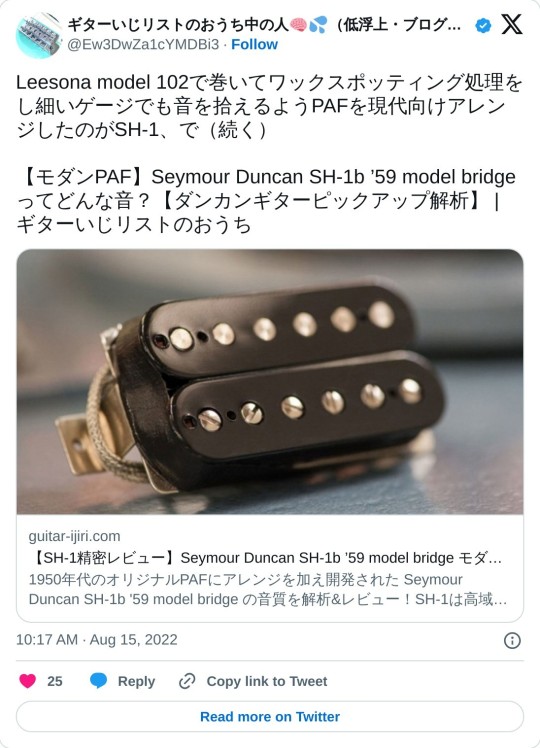
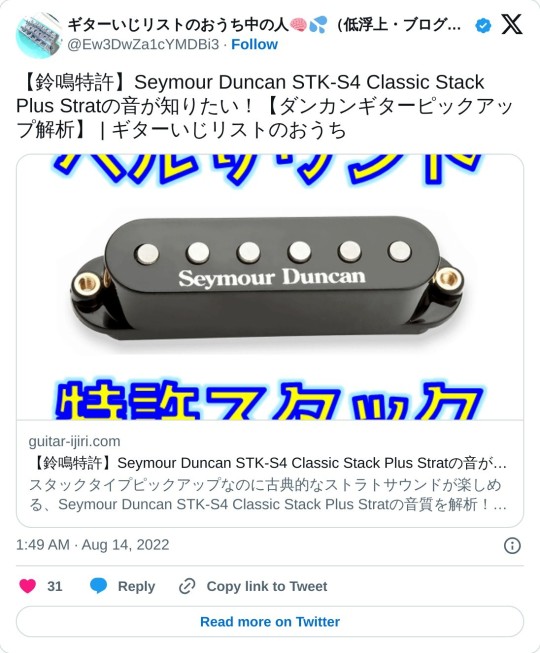


#guitar#electric guitar#guitar-ijiri.com#review#spectrum#seymour duncan#ギター#エレキギター#レビュー#ギターいじリスト#guitar pickups#pickups#ピックアップ#ギターピックアップ#ブログ#blog#blogger
85 notes
·
View notes
Text
Enhance Your Sound: The Power of a Pre-Loaded Strat Pickguard with Seymour Duncan Guitar Pickups by SolderX
Upgrading your guitar tone doesn’t have to be complex. One of the best ways to achieve a powerful sound is with a pre-loaded Strat pickguard featuring Seymour Duncan guitar pickups, and SolderX makes it easy. This modification not only elevates your guitar’s look but also transforms its sound, offering the kind of tone that stands out on any stage or recording. Let’s explore why this combination is so popular among guitarists.
0 notes
Text
this beautiful afternoon I give you the better...
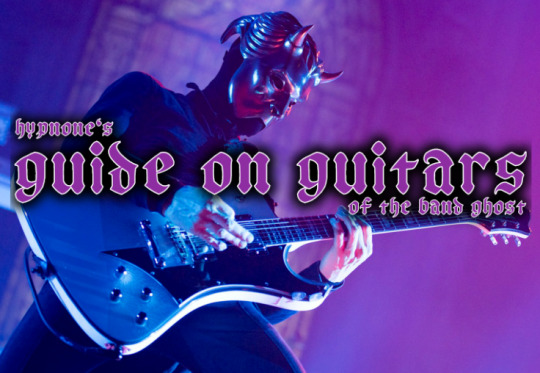
Alpha Era I
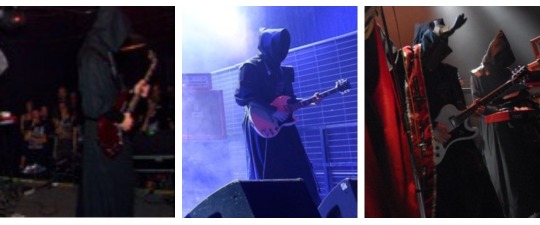
Gibson SG Standard in Heritage Cherry
Gibson SG Standard in Classic White
White Gibson RD
Omega Era I

2009 custom Gibson RD Standard Reissue in black gloss
Black and white Gibson Kirk Hammet 1979 Flying V
I'm not sure about this one. It looks like a Pureslem Cardinal but it's a bit off, plus the neck and head don't match, they look Gibson-ish. It may be a custom, no-name or a mix.
Alpha Era II
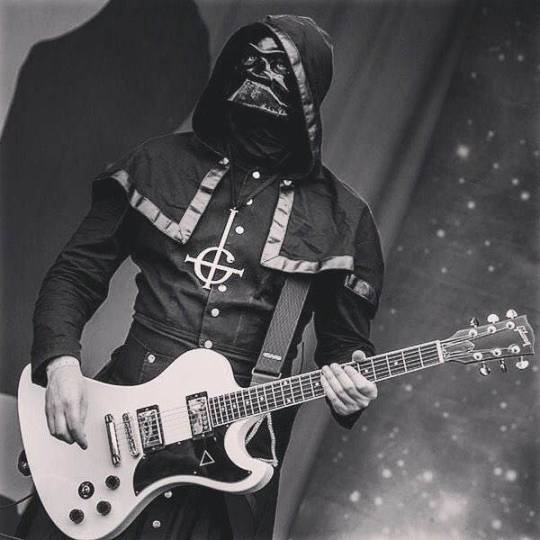
White custom Gibson RD
Omega Era II

2009 custom Gibson RD Standard Reissue
Alpha Era III
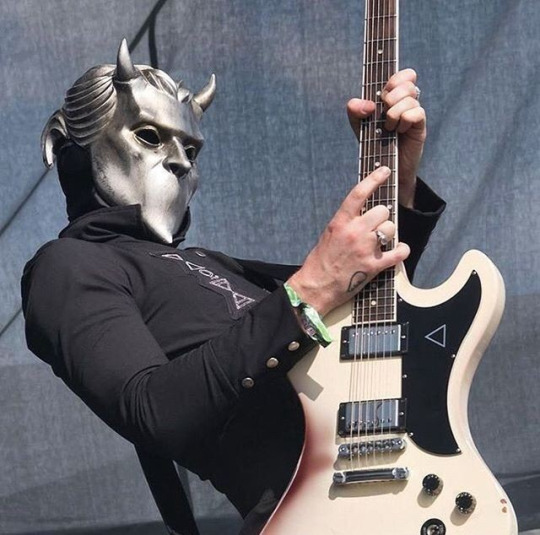
White + red custom Gibson RD
Omega Era III

1977/1978 Gibson RD Artist Sunburst
2009 custom Gibson RD Standard Reissue in black gloss
Delta Era III

Gibson SG standard in black gloss
Ifrit Era III
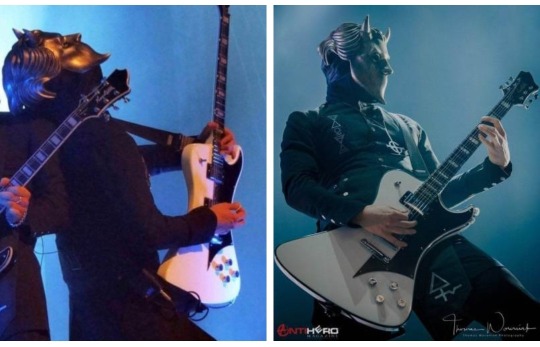
Unknown version of Hagstrom Fantomen Stock White Gloss
Hagstrom Fantomen Stock White Gloss
Aether Era III

Hagstrom Fantomen Stock Black Gloss
Dewdrop Era IV

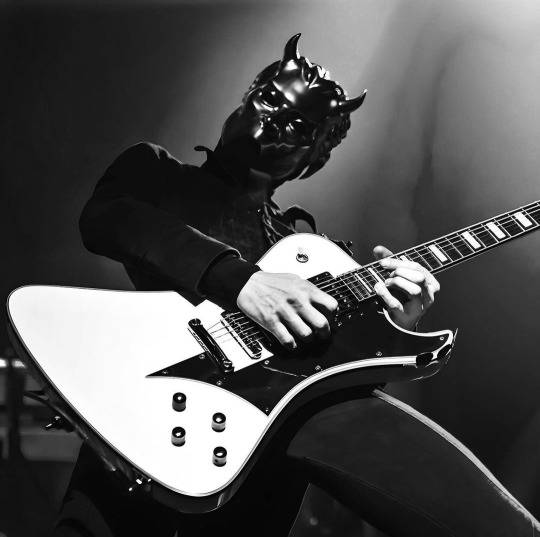

Hagstrom Fantomen Stock White Gloss with mods
Hagstrom Fantomen Custom White Gloss with mods
Hagstrom Siljan II Dreadnought CE in black gloss acoustic
Aether Era IV



Hagstrom Fantomen Stock Black Gloss
Hagstrom Fantomen Custom Black Gloss
Hagstrom Siljan II Grand Auditorium 12 String acoustic
Swiss Era IV


Hagstrom Viking Deluxe Baritone in black gloss
Hagstrom Siljan II Dreadnought CE in black gloss acoustic
Rain Era IV

Hagstrom Siljan II Dreadnought CE in black gloss acoustic (borrowed from Swiss for the duration of the acoustic set)
Dewdrop Era V


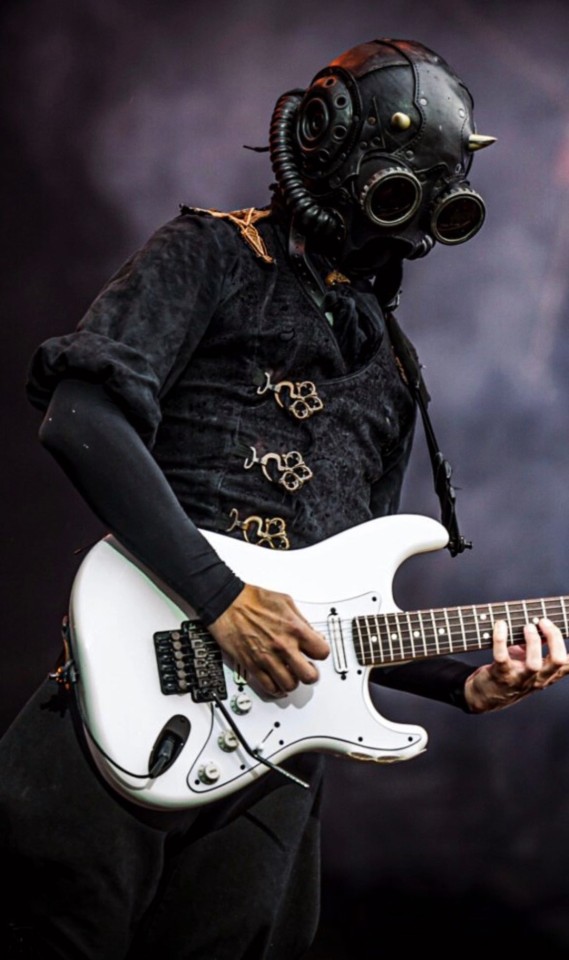


This is a bit tricky so I'm giving a disclaimer at the beginning. There's enough Stratocaster models and versions for me to not be able to determine them with 100% accuracy, especially with the way Dewdrop has them all modified and customized. Stuff below are my best guesses based on the knowledge I have, but that would mean even more customizations and possibly swtiching out the necks, so just keep that in mind.
Olympic (dirty) White Fender EOB Signature Sustainer Stratocaster with some personal-preference kinda mods
Olympic (dirty) White Fender LTD American Performer Stratocaster with heavy mods, including Seymour-Duncan Hot Rail pickups and Floyd Rose locking tremolo system
Arctic/Polar (pure) White Fender LTD American Performer Stratocaster with heavy mods, including Seymour-Duncan Hot Rail pickups and Floyd Rose locking tremolo system
Olympic (dirty) White Fender LTD American Performer Stratocaster with lighter mods, including Seymour-Duncan Hot Rail pickups
Arctic/Polar (pure) White Fender LTD American Performer Stratocaster with lighter mods, including Seymour-Duncan Hot Rail pickups
Aether Era V
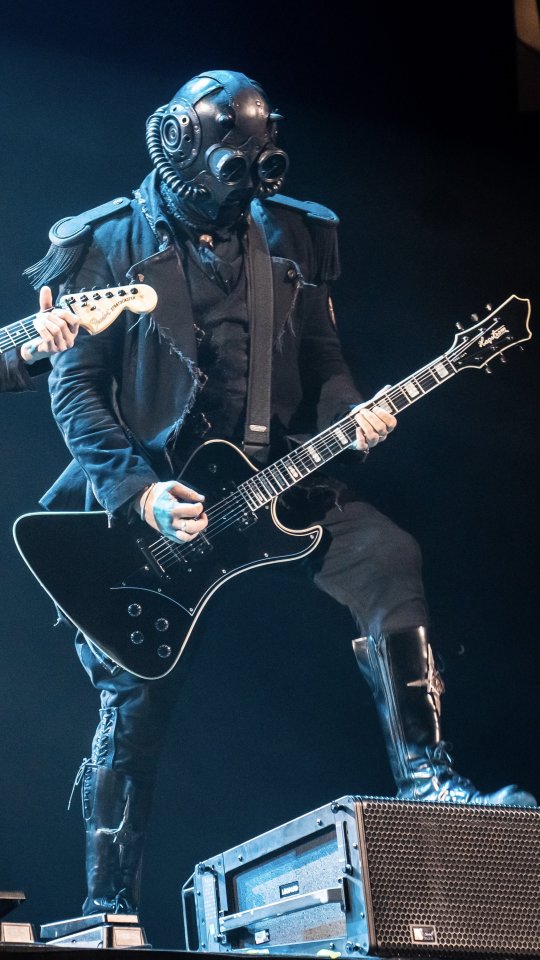
Hagstrom Fantom Custom (with additional mods) Black Gloss
Swiss Era V
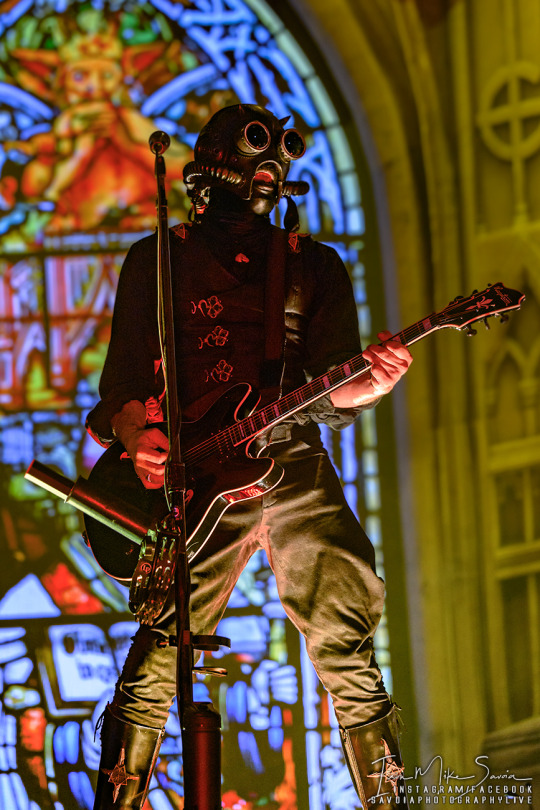
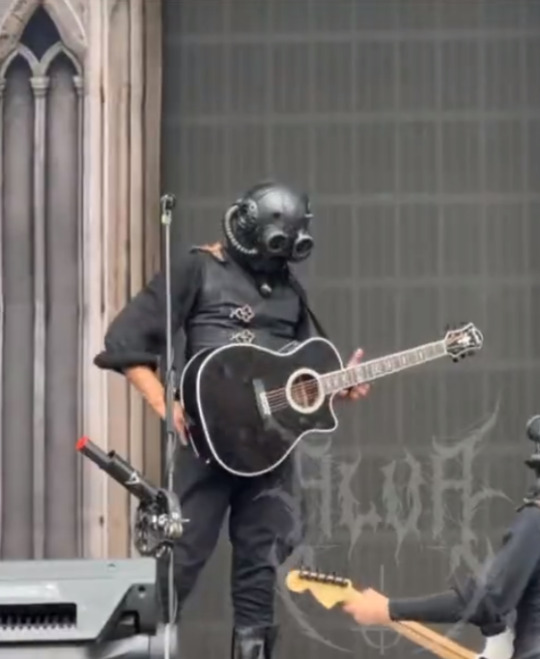
Hagstrom Viking Deluxe Baritone in black gloss
Hagstrom Dreadnought CE in black gloss acoustic
Aeon Era V
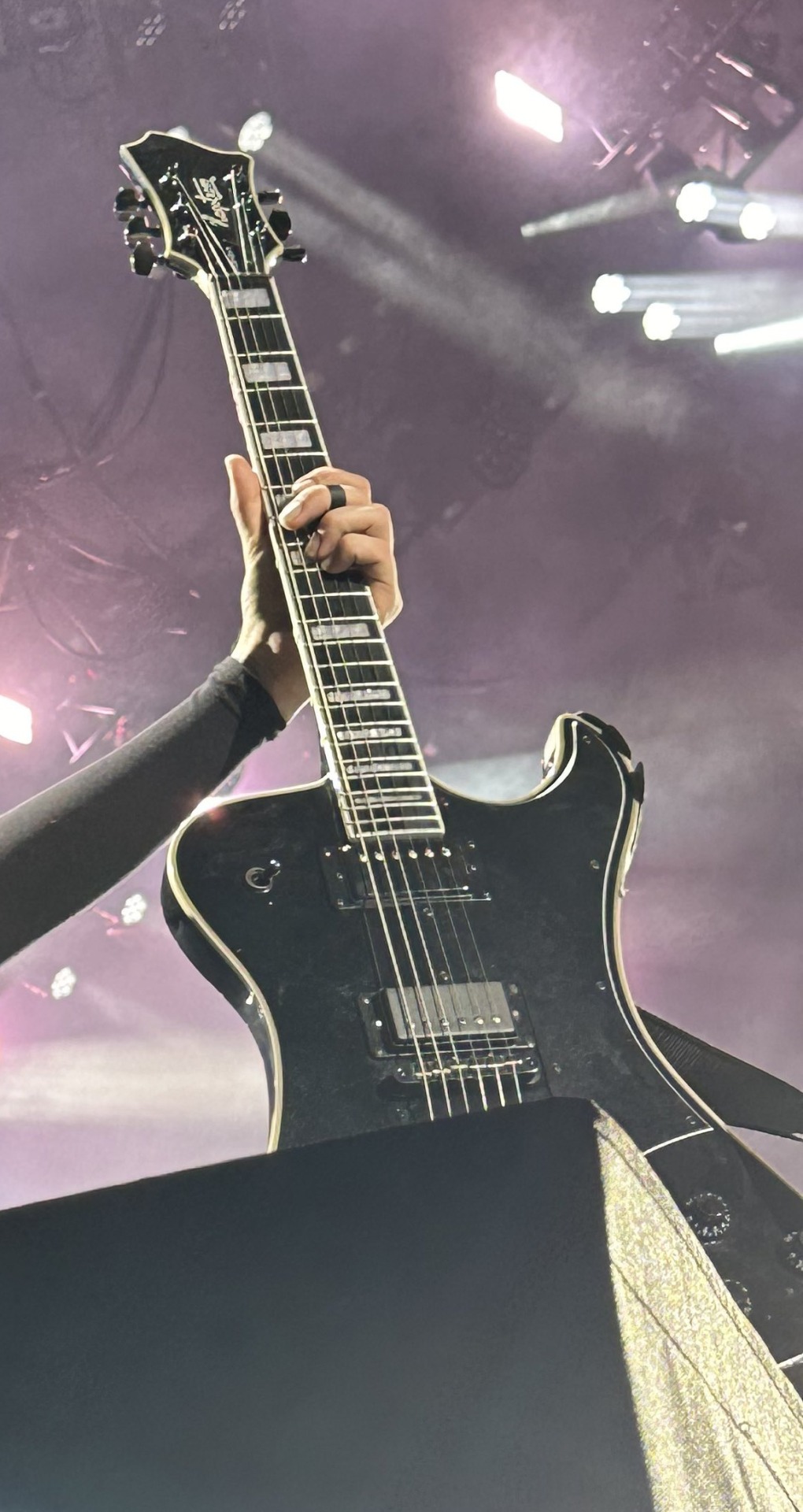
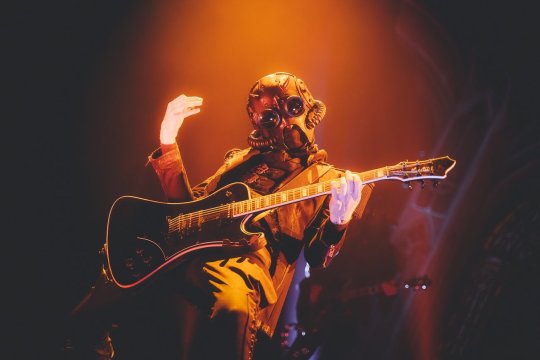
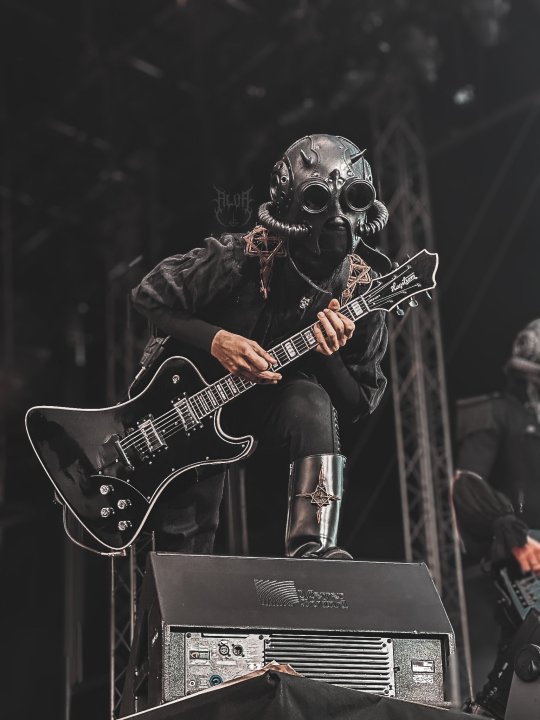
Hagstrom Fantom Custom (with additional mods and mismatched pickups) Black Gloss
Hagstrom Fantom Custom (with additional mods) Black Gloss
Hagstrom Fantom Stock Black Gloss
and again, if anyone has any questions my askbox is open as usual :3
#the band ghost#nameless ghouls#dewdrop ghoul#ifrit ghoul#alpha ghoul#omega ghoul#delta ghoul#aether ghoul#phantom ghoul#aeon ghoul#swiss ghoul#rain ghoul#hypnone gear talks
222 notes
·
View notes
Text
an overview of paul's guitars
before we look into pauls gear, i want to make sure we all are aware that im talking about the guitars he used WITH interpol. ill add some notes on his other instruments at the end of this post.

[paul with his and daniels guitars]
LES PAUL CUSTOM
"I've owned my Les Paul Custom since high school... its all I pretty much use today."
from what i can tell, paul has two les pauls, and he uses them interchangeably. first, though, id like to do a quick spec overview. his guitars have an ebony finish, and seeing as this guitar was most likely acquired in the 90s, gibson 490r and 498t pickups. in almost every picture i see of his les pauls, it seems he or a guitar tech have switched out the stock gold bridge with a black one. im not a gibson expert, so im not sure of the exact model, but it looks to be a tune-o-matic style bridge. he also has removed the covers on the pickups of his guitar. another quick note, in photos from around 2004 to 2005, there is a square shaped hole cut clean through his piece of velcro on his les paul. this was done to hold his ebow during take you on a cruise. thats all the specs/mods to show, ill put some pictures highlighting the points ive gone over.

[a close up of one of pauls les pauls, 2015. note the bridge, and absence of pickup covers]

[what i thought was a hole turned out to be a piece of velcro]

[hole has been blocked/filled! may 21, 2005]

[early picture of paul, with his pickup covers still on. very modest]
JAGUAR
"The Jaguar actually came about specifically within Interpol because I had written a part in which I wanted whammy, and I don't like Les Pauls with Bigsbys."
from what i can deduce, i think this guitar is a fender american vintage jaguar from 2005-06, in black. paul hasnt done too many mods to this instrument, though their are a few changes, most importantly, the pickup swap. he changed the stock jaguar pickups to seymour duncan hot rails sometime after recording our love to admire. while this definitely changed the sound a bit, this was after OLTA, so i wont bother finding dates, as the songs the jaguar was likely used on wouldve been the stock single coils. next up, the pickguard. the american vintage jags in black came with a tortoise shell pickguard, but pauls has a black one. what gives? well, seeing as carlos' jazz bass came with a white guard, but that was switched to black, its not outlandish to believe that this was done by paul or his tech, to give the jag a darker look. paul also put tape on the guitars lower horns control switches, most likely to stop his hand from accidently hitting the switches, and changing his sound mid song.

[paul with his jaguar, before he swapped the pickups.]

[another pic before the pickup swap. note the tape on the control panel.]

[a later pic, where we can see he added MORE tape to the guitar, and after he swapped the pickups to hot rails.}
INTERMISSION
if you ask me, pauls les paul custom and jaguar are the two guitars youd definitively need to get his sound, and also the two guitars HE uses to get his sound. but what other guitars has paul used with interpol? lets see.
LES PAUL DELUXE
used during the TOTBL era, this guitar is sort of a mystery. for one, he didnt seem to favor it for certain songs, using his les paul custom and deluxe interchangeably for many songs, even playing full shows with his deluxe. secondly, from what ive seen, this instrument was NOT used after the TOTBL era. its probable that this instrument was either used on a few songs from TOTBL, and brought along on tour as a backup that paul just happened to really like and play alot, or it was rented for shows over seas. either way, its an interesting case.

[the mysterious gold top deluxe. wonder what song hes playing here?]
FLYING V
paul has stated that he thinks the flying v is the coolest looking guitar out there. to each their own, i guess. that doesnt matter, what matters is that he played this instrument in the barricade music video. he used this guitar at the end of the OLTA era, during the self titled era, and has rarely been seen with it after that. most likely has the same pickups as his les paul custom, but dont quote me on that.

[as long as he likes it.]
CONCLUSION
there is one more guitar i didnt bring up, so ill do it here now, and its his dave murray strat. he hasnt used it live with interpol, though it is seen in behind the scenes footage of el pintor. anyways, leave a comment if youd like me to cook up a list of what guitars i think were used on each song! i hope you enjoyed reading this, next up i think ill go over his amps and other equipment. till next time.

[Paul Banks.]
49 notes
·
View notes
Note
What guitars and basses are being used on this tour? I like asking about stuff like this
Skylar's main guitar is a Fender partscaster Strat that she built herself. It's just got some Alnico 5 pickups in it, HSS. The backup strat is a 2000s-Era MIM Fender with Seymour Duncan mini hunbuckers in it.
Trent is on a Gibson Les Paul Studio running through a Vox AC30.
Raine is playing on a Music Man Stingray running through a Darkgass preamp.
10 notes
·
View notes
Text
🎶😀🎸Making Guitar Pickups with Seymour Duncan | Factory Tour
youtube
Cool beans... Duncan Factory is in Santa Barbara
#jamesguitarshoppe#guitar world#guitar player#rolling stone magazine#music#fun#guitars for sale#Youtube
3 notes
·
View notes
Text
Gears & Analysis - Manson Delorean [STYLE Series #004 - Muse (August 2010)]

DeLorean The steadfast mainstay of the band's early days, custom-made with near-future imagery.
The first guitar Matthew ordered from Manson, it appeared in 2001 and became his main guitar for live performances and recordings until he retired it in 2005. It is called the ‘DeLorean’ (often called the Silver Manson) because of its futuristic looks, reminiscent of the DeLorean car in the film Back to the Future. The body, which at first glance appears to be made of metal, is actually just laminated aluminium sheets on wood. The body is made of mahogany (some say poplar) and the neck is made of high-grade maple with a beautiful bird's eye grain and a rosewood fingerboard. Pickups are Seymour Duncan ‘Hot P90’ front and Kent Armstrong ‘Motherbucker’ rear. The latter is constructed like two twin-blade single-coil sized humbuckers and is characterised by its extremely powerful tone. The unit also incorporates a Graphtech ‘Ghost Pickup System’, which can be used to create pseudo-acoustic sounds by utilising the output from a piezo pickup built into the bridge saddle. The GK-2A guitar synth system from Roland is also built in, so this guitar can be used to create not only normal guitar and acoustic sounds, but also synthesised sounds when connected to a GR-series guitar synth. The GR series is a guitar with a wide range of options. In addition, the backside of the guitar has a large zigzag at the bottom (not visible in the photo), where a board containing various effectors is built in (this model is equipped with the ZVex Fuzz Factory and MXR Phaser Phase 90 circuits). In other words, this is a guitar with a wide variety of functions that allows you to complete your sound makeup with just the guitar itself and an amp, without having to install effects pedals under your feet.
Controls There are a number of controllers and switches to control a variety of functions. As seen in the live video, the two silver knobs at the bottom of the unit are probably for the ‘Fuzz Factory’ and the knob on the right side of the bridge is for the ‘Phase 90’. The mini-switches are probably ON/OFF switches for the effects, guitar synths, and piezos. The three small knobs on the right side of the unit are probably normal guitar controllers.
Head Stock The head is shaped in a way reminiscent of a Telecaster, to which an aluminium plate is affixed. All six pegs are placed on one side. The functionality is orthodox, but the circular knobs help to give the guitar a futuristic look. The rosewood fingerboard is rounded rather than slab board, as the joint between the fingerboard and neck is rounded and arced.
9 notes
·
View notes
Text
Saturday’s project is shaping up.

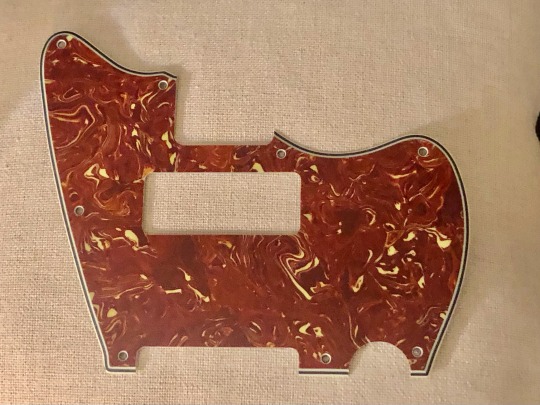
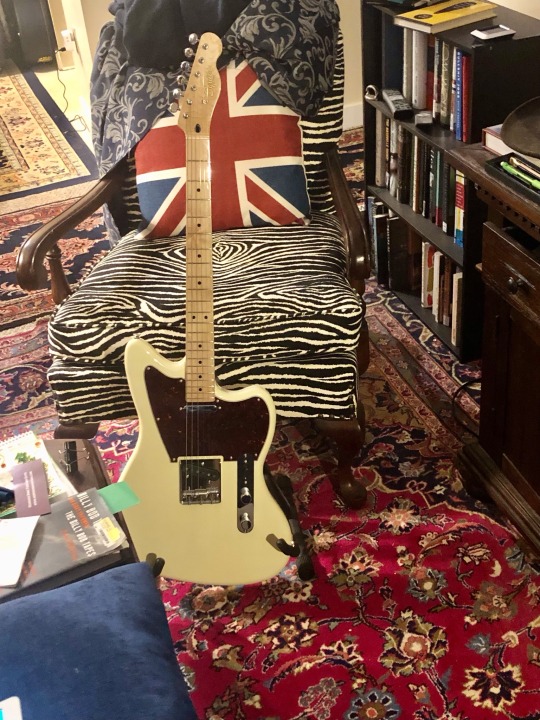
I’m going to replace the neck pickup with a Seymour Duncan Antiquity Soap Bar P-90.
Even bought a fancy new pick guard.
@therockandrollyears
21 notes
·
View notes
Text
Discover Jimmy Page
A complete list of his most famous electric guitars - pt. 1
from pageysartgallery
1959 Fender ‘Dragon’ Telecaster - restored in 2007
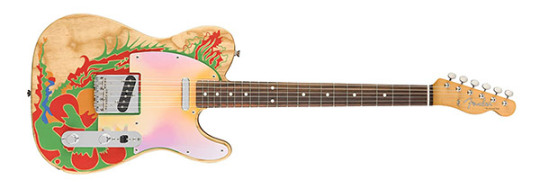
Finish: Custom yellow with dragon painting, it was originally white
Years used: 1966 to early 1970s, only the body is left of it
When Jeff Beck was recommended by Page to join the Yardbirds in 1965, Beck gave him this 1959 Fender Telecaster, which originally had a white finish. In 1967, Page decided to add eight circular mirrors to the body, completely changing the instrument’s visual identity. Eventually, he removed the mirrors and completely repainted the guitar in a yellow-ish color, and added the now-famous dragon painting.
This was the main Zeppelin guitar, live and in the studio from from 1968 to April 1969. It was also used on the solo for “Stairway To Heaven” in the studio.
Unfortunately, when Page got back from Zeppelin’s American tour, he found out that one of his friends had repainted it. Although intended as an act of kindness, his friend practically ruined the guitar and its wiring. Page disassembled the poor instrument and used some of its parts on other guitars. The body is reportedly still in his possession, but he refuses to share pictures of it with the public.
“The whole idea was to put an extra life into the guitar. The whole of the Dragon artwork it starts off – I don’t do a sort of a pre-run of it. I wanted to use sort of poster paint which was used in the production of those psychedelic posters.”
— Jimmy Page (x)
1961 Danelectro Shorthorn - a bit of a mongrel, made from the best bits of two Dano's

Finish: Black with a white pickguard
Years used: Mid-1960s to now
Danelectro guitars used to have major success back in the 1960s. Formed in 1947, the company operated independently until 1966 when it was sold to the Music Corporation of America. Unfortunately, the brand went under in 1969, only to be resurrected in the late 1990s.
In his vast arsenal of guitars, Jimmy Page still has his old Danelectro Shorthorn model, also known under designated names 3021 and 59DC. This particular instrument, featuring two “lipstick” single-coil pickups, was manufactured back in 1961 and Page bought it in the mid-1960s. The story goes that he first used it on stage with the Yardbirds. Occasionally, the guitar found its use with Led Zeppelin. The guitar is often associated with “Kashmir” as it was used for the song many times during Led Zeppelin’s shows.
It is a very simple instrument with a hardtail bridge, a 3-way switch for its two pickups, master volume control, master tone control, and a pretty-looking white pickguard covering most of the treble side of the body. And, what many guitar lovers don’t know, Danelectro Shorthorn actually features a semi-hollow body.
1959 Gibson Les Paul Standard - The ‘Number One’. The most iconic and still Jimmy’s favourite and most used Zep guitar. Noticeable lack of flame finish.

Finish: Sunburst
Years used: 1969 to now
This is a Gibson Les Paul Standard model built back in 1959 or early 1960. These instruments are popularly known as “Holy Grail” guitars and can reach some mind-boggling prices among avid collectors. This particular one found its way into Jimmy’s collection in 1969 when Joe Walsh, who later became a member of the Eagles, gave it to him as a gift. As Walsh explained many years later, he just thought that Jimmy needed a nice Les Paul in his collection, since it fits Zeppelin’s music.
The instrument saw some modifications before it came into Page’s possession. One of the main changes was the neck, which was sanded, thus making it significantly thinner. Jimmy did some of his own changes by adding gold-plated Grover tuning machines, as well as changing its pickups multiple times. The pickup that saw the most action on it in the 1970s was T-Top humbucker. This one was eventually swapped in the 1990s for a modified Seymour Duncan, and Page even added a “push-pull” potentiometer to it for the reverse phase mode of operation. The guitar still remains his “Number One” to this day.
“As soon as I played the Les Paul I fell in love. Not that the Tele isn’t user friendly, but the Les Paul was gorgeous and easy to play. It just seemed like a good touring guitar. It’s more of a fight with the Telecaster but there are rewards.”
— Jimmy Page
Custom-Made Gibson EDS-1275

Finish: Cherry red
Years used: Most of the 1970s, it’s most likely still in his possession
When you think of Led Zeppelin and the 1970s, it’s almost impossible not to picture Jimmy Page with his legendary double-neck guitar. This is mostly due to the fact that he used it for “Stairway to Heaven” during live shows.
Gibson’s EDS-1275 is one of the most innovative guitar models. Entering production in 1963, it is believed that this was the first-ever double-neck solid-body electric guitar. Featuring one conventional 6-string neck and another 12-string neck, all with a double set of pickups, it allowed guitar players to create more tones with a single instrument.
Page asked Gibson to make him one in 1971, although EDS-1275 was not in production anymore at that point. Nonetheless, they agreed and made a special one for him, which featured a modified body shape compared to the original commercially available model. It’s not completely certain, but it’s quite possible that Jimmy Page popularized the instrument so much that Gibson eventually started making them again throughout the 1970s and later decades.
“We recorded Stairway to Heaven, and there was like a guitar army on it – as they used to tease me. Because of that, it needed more texture than just one guitar. The double-neck seemed like a perfect compromise.”
— Jimmy Page (x)
1960 Gibson Les Paul Custom ‘Black Beauty’ - Jimmy's main session guitar, used at Royal Albert Hall in 1970 and a few other early gigs. Stolen in 1970, recovered 2018.
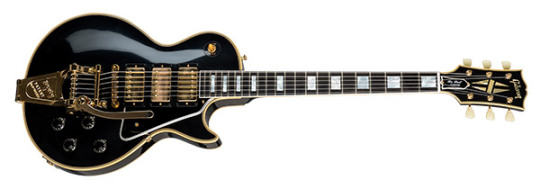
Finish: Black with golden hardware
Years used: Early 1960s to 1970
Things really took a different turn when Jimmy Page switched over to Les Paul guitars full-time, which eventually became his go-to guitar model. However, he actually got his hands on one way before Led Zeppelin’s formation, sometime in the early 1960s. Nicknamed “Black Beauty,” this was a black Gibson Les Paul Custom, most likely manufactured back in 1960. Some sources claim that he traded his Gretsch Chet Atkins signature model for it.
Jimmy used “Black Beauty” as the main guitar for his session work. Of course, the instrument found its way on early Led Zeppelin records. Being a Les Paul Custom model, it featured some significantly improved aesthetic traits. This includes 3-ply binding, golden hardware, black pickguard, the easily-recognizable pearl logo on the headstock, and pearl inlays on the fretboard. Additionally, the guitar came with a Bigsby tremolo bridge and tailpiece, as well as three humbuckers.
Jimmy Page was scared to take it on the road with him. And when he finally did go overseas to the United States, his precious “Black Beauty” got stolen. Its whereabouts were a mystery for decades until the instrument was finally retrieved in 2015. It still remains one of the most iconic guitars in history.
“Black Beauty, which got nicked in the States; it disappeared in an airport, somewhere between Boston and Montreal. A lot of my studio work had been done with that guitar. I didn’t want to take it out of the house. Funny that once I did take it out, it got nicked!”
— Jimmy Page, Guitar World, 1991
1959 Gibson Les Paul Standard - ‘Number Two’ bought as a backup in 1973, slightly darker sunburst than the #1. It's a bit meatier and louder than the #1 according to Jimmy's guitar tech.
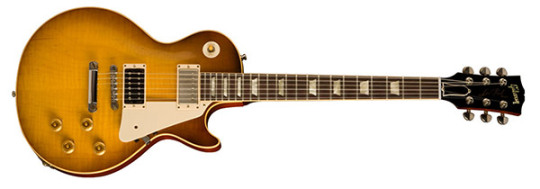
Finish: Sunburst
Years used: 1973 to now
Jimmy fell so much in love with his Gibson Les Paul Standard that he got ahold of another “Holy Grail” in the early 1970s as a backup option, popularly known as the “Number Two.” In order to make it feel and sound exactly the same as the “Number One,” he did some significant modifications to it, including the neck sanding and the addition of Grover tuning machines. But although it looks pretty similar to the “Number One,” this Les Paul Standard has a slightly darker shade, making it look browner.
Compared to the main Les Paul, this one had more modifications done to its electronics. All four of its potentiometers were swapped for “push-pull” ones and there are even some additional switches. As a result, Jimmy was able not only to do phase reverse but also coil-splitting and coil-tapping, allowing for an abundance of sonic options.
“I customized my number two Les Paul, which again is a real old vintage one. However, that gave any combination of all of these (pickups). But, it was a little fussy, because all of the knobs were push/pull, and I had little switches (below the pickguard).
Reality of it was – the thing that I found most important to me was the fact that you could reverse the phase on this. By reversing the phase you get a close approximation to the sound Peter Green would get.”
— Jimmy Page (x)
1969 Les Paul Deluxe - ‘Number Three’, metallic purple red, as seen on “Whole Lotta Love” on TSRTS

Finish: Red
Years used: From 1970 or 1969
Page’s love for Les Paul guitars has always been immense. So it’s no wonder that he also had his “Number Three,” which is a Gibson Les Paul Deluxe model. However, not much is known about the instrument, and some believe that this was a Les Paul Standard. But what makes it interesting is, that besides being traditionally a “third” one, he actually got the guitar before the second Les Paul Standard.
The “Number Three” was used sporadically throughout the 1970s, mostly between ’73 and ’75. Towards the mid-80s, Jimmy installed a B-Bender in it and started using the guitar again more extensively. Most recently, he used it on “Over Now” from the 1993 release Coverdale / Page.
“Probably my favorite effect was the one used on “Over Now.” After David sings, “I release the dogs of war,” you hear this growl. I produced that by running my purple B-Bender Les Paul through an early-sixties Vox wah, a DigiTech Whammy Pedal set “deep,” an old Octavia, and one of my old one-hundred-watt Marshall Super Leads, which I used with Zeppelin.”
— Jimmy Page, ‘Light and Shade: Conversations with Jimmy Page’
1964 Fender Stratocaster - Used at Earls Court in 1975 for one night only on “No Quarter” plus on “For Your Life” from Presence and on ITTOD. Also used at Knebworth in 1979 and '80 tour on “In The Evening”
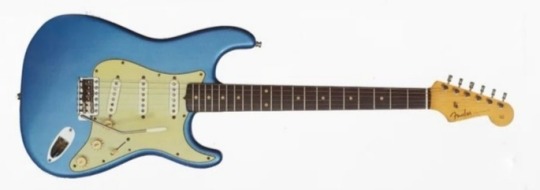
Finish: Lake placid blue
Years used: Second half of the 1970s and 1980s
A 1964 Fender Stratocaster model, painted in a very aesthetically pleasing shade of blue (referred to as “lake placid blue”) and featuring a classic white electronics cover. While most of the features on this model are what you’d expect from a Fender Strat, these 1960s models featured rosewood fretboards instead of “conventional” maple ones.
The story goes that Page bought it back in 1975 and that it was used on Zeppelin’s “Presence” album for a few songs, although this has not been confirmed. Page claimed that the instrument was used since 1978, and there’s also a theory that he implemented it on the 1979 album “In Through the Out Door.”
1950s Futurama/Grazioso
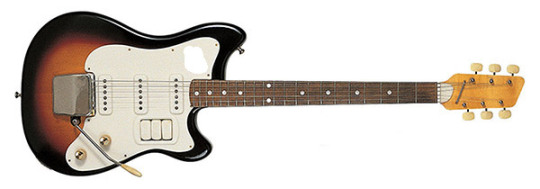
Finish: Sunburst
Years used: Late 1950s to the mid-1960s
These guitars were made in Czechoslovakia by a company called Drevokov. Originally called Grazioso for their domestic market, they had their name changed to Futurama for foreign markets. These came with three single-coil pickups, tremolo bridge (a type that you don’t see on any other known guitars), sunburst finish, and a body that somewhat resembles Fender’s Jazzmaster. It featured many other unconventional traits, including individual on-off pickup switches that eerily resemble old light switches.
Page used this one at the very beginning of his guitar-playing career. It’s not exactly certain when it stopped being a part of his inventory, nor where it’s currently at, but it’s assumed that this Futurama saw some action during Page’s time as a session guitar player in the first half of the 1960s.
“See, that’s the first electric guitar I get. The one before it, the Höfner, my dad buys that, but after that, [he laughs]—I don’t know, maybe he was psychic and he knew what was coming, because there’s a whole procession of guitars that come into my life over the next few years. But that’s the first one, the Grazioso. It looked and felt like an electric guitar, even though it wasn’t a Fender.”
— Jimmy Page (x)
1965 Fender Electric XII
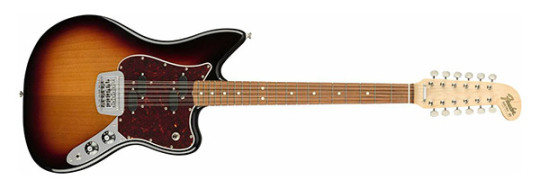
Finish: Sunburst
Years used: Early 1970s and it’s most likely still in his possession
Before the Gibson EDS-1275, Jimmy had another 12-string guitar, Fender’s old Electric XII. This particular instrument was manufactured sometime in 1965. It was used in the studio, most popularly for the recording of “Stairway to Heaven.” However, producer Andy John who worked with Zeppelin on their legendary fourth record claims that it was actually a Rickenbacker 12-string that was included in the song. It’s still one of the main mysteries, even to this point.
Fender’s Electric XII is easily recognizable for its weird “hockey stick” headstock. It also has two split-coil pickups, which is another very unconventional trait for electric guitars as you mostly see these kinds of pickups on basses.
“I used a Fender 12-string in the studio. And before the Fender, I used a Vox 12-string. You can hear the Vox on things like “Thank You”, and “Living Loving Maid”. On “Stairway” I used both my Vox Phantom that I used on “Thank You” and my Fender Electric XII. They both sort’ve sounded the same. It was more about how they played. They felt different. On “The Song Remains The Same”, it’s just the Fender.”
— Jimmy Page (x)
sources: (x) (x) (x) (x)
Featured in the next part: the 1953 brown Fender Telecaster, the 1967 Vox Phantom XII, the 2nd no3 Gibson Les Paul Standard, the Gibson Les Paul TransPerformance, the Gretsch Country Gentleman and the Fender Telecaster with its regular white finish and circular mirrors glued to the body
#jimmy page#pageysartgallery#led zeppelin#the firm#the yardbirds#robert plant#john bonham#john paul jones#paul rodgers#60s#70s#80s#classic rock#classic rock fandom#rock n roll#hard rock#blues rock#rock music#jeff beck#discover jp#guitars#guitar#guitarist#gibson#fender#telecaster#stratocaster#danelectro#by dee dee 🌺🕯️
69 notes
·
View notes
Text

Here’s another gorgeous original 1959 Les Paul Standard from Slash’s guitar collection. ‘The attack is totally different,’ says Slash when asked what plugging in an original ’Burst is like when compared to one of his Gibson signature models. ‘You don’t play it as hard. And it has certain nuances that you really want to stick out, so maybe you play it a little cleaner. The Seymour Duncan pickups that I use aren’t high output Seymours, either – they’re sort of medium output. But they’re just a little bit hotter than original PAFs.’
This guitar features alongside hundreds more in The Collection: Slash, from Gibson Publishing – a premium coffee table book from Gibson Publishing. Learn more: https://ow.ly/rkEn50Qi0gP
📸 Photo by Mitch Conrad
#gibson #gibsonpublishing #slash #slashnews
6 notes
·
View notes
Text
[Review] What Does the Seymour Duncan Cory Wong Clean Machine Bridge Stack Sound Like? _ ギターいじリストのおうち guitar-ijiri.com
Seymour Duncan analyzes and reviews the sound quality of the Cory Wong signature Cory Wong Clean Machine!This time, we are looking at the stacked type for the bridge!The bridge version is a stacked type using an overwound coil and Alnico 5!Analyzed overtones, clean frequency response, and overdrive frequency response!
#Seymour Duncan#guitar#electric guitar#guitar parts#guitar pickups#Cory Wong#Cory Wong Clean Machine#CORY WONG CLEAN MACHINE-b (Bridge)#guitar-ijiri.com#review#spectrum#pickups#blog#blogger#DIY#music#guitarist#over drive#Clean#Funk#signature#stack#stack type#Alnico5#AlnicoV#guitar pickup
30 notes
·
View notes
Text
Premium Guitar Pickups by Seymour Duncan at SolderX
Explore the unmatched quality of Seymour Duncan guitar pickups at SolderX. Our collection includes a range of pickups that deliver rich, dynamic tones for any genre, from classic single-coils to high-output humbuckers. Ideal for players seeking enhanced clarity and depth, Seymour Duncan pickups offer a transformative upgrade to your sound. Discover how SolderX can help elevate your guitar’s performance and style with these top-tier pickups.
0 notes
Note
hey man, i've been wondering about les paul style pickups i can get to install in my guitar to replicate jonny's smile tone. any ideas that are relatively cheap?
alternatively, how would getting p90s be in comparison to that?
The Gibson Humbucker is probably the most popular and most replicated pickup of all time. Officially, there was just one model from its introduction in 1957 until the 1990s. But Gibson made some tweaks over the decades. Jonny’s Les Paul looks to be from 1977-1978, so it probably has what are known as “T Top” humbuckers.
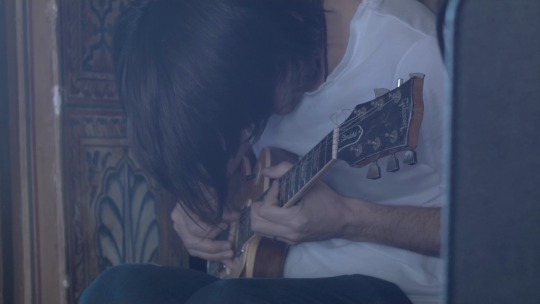
Jonny playing his late-70s Gibson Les Paul Standard in natural finish, from during the recording of Junun at the Mehrangarh Fort in Rajasthan, India.
Compared to the average late-50s “PAF” pickup, the 70s "T Top" is said to have a slightly more aggressive sound. That said, the difference isn’t dramatic. A T Top still has the warm, rich sound that we associate with a vintage PAF. It’s not like a 70s hot-rodded humbucker, let alone a modern rails humbucker. And it's worth remembering that 50s PAF pickups could themselves vary noticeably in sound due to inconsistent winding.
Jimmy Page’s circa-1959 Les Paul originally had PAF pickups, but, when the bridge pickup malfunctioned on tour in Australia in 1972, he replaced the 50s PAF with a 70s T Top. Page kept the T Top in the guitar for the rest of Led Zeppelin’s career. That should suggest how slight the differences are between the versions.
So if you’re really picky, you could track down a T Top replica or reissue. There are plenty available at nearly every price point. If you’re less picky, grab one of the countless PAF replicas and reissues. If you're on a budget, perhaps consider the the Seymour Duncan '59 (a PAF replica): it's extremely popular, and thus pretty cheap on the used market.
Unless you've got the exact same amplifier as Jonny with a mic in the exact same position on the grill, then I wouldn't worry too much about the subtle differences between various vintage Gibson humbuckers.
For a comparison of P90s and Humbuckers, I’d recommend searching other sites and forums, it’s an extremely well-trodden topic.

Jonny playing his Les Paul during Open The Floadgates on KEXP (youtube). This was from a brief period of a few shows when the pickup selector was taped in the bridge position — presumably the neck pickup had some issue. Jonny can't stick picks into the pickguard of the Les Paul (as he does with his Tele), so he has a Dunlop 5005 pick holder velcro'd to the guitar.
8 notes
·
View notes
Text
Okay. So. Project guitar time. I picked up this daphne blue Jazzmaster body off of ebay for like, $100 and decided that it was time to build a guitar that filled a niche that I haven't yet.

So. For context my other two main guitars are a squier Jaguar that I use in my band, using AV '62 Jaguar pickups and modded a bit to make it more of a vintage feel, and my Strat which I use for more classic rock tones and other stuff with an HSS setup, using two random single coils again off of ebay and a Seymour Duncan pickup that I added a coil split push pull pot on the guitar for. I dont use the strat outside of my room very often because it has a floyd rose on it, and i can never get it to stay in tune if its not in a climate controlled area that it stays in for a while. yeah. its a pain in the ass.

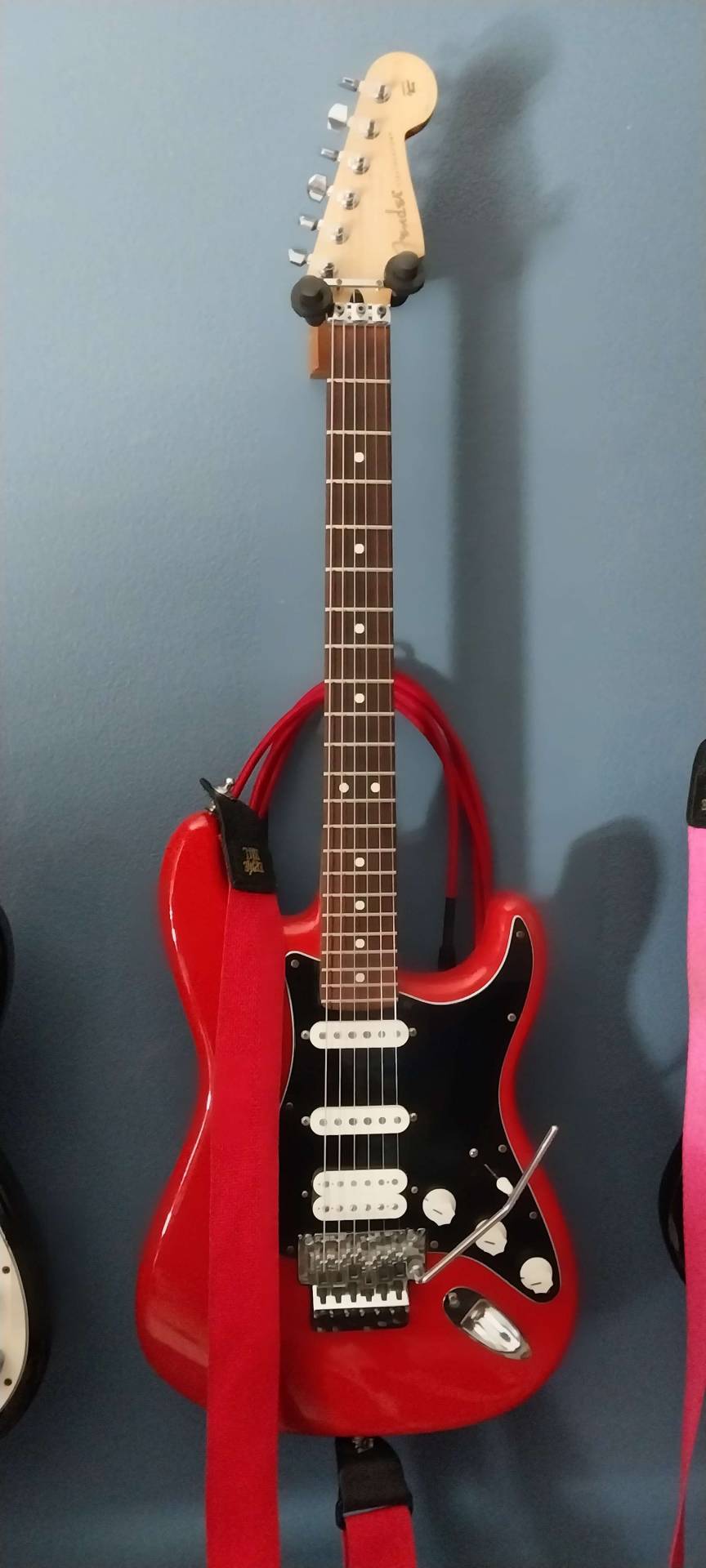
So. What am I missing if I have these two guitars? well. As much as i love the classic Jazzmaster pickups and have enjoyed every instrument i've laid my hands on with them, I very much do not have a normal humbucker guitar that I just pick up and use as a humbucker guitar. My strat has a humbucker, yes, but like. A strat neck pickup is just. a strat neck pickup. its too sweet not to use when holding that guitar. the bridge pickup on my strat pretty much gets used when im playing punk, otherwise its in single coil mode mixed with the middle pickup.
But im not looking for like, a les paul sound. no. i want funky weird pickups that arent seen everyday. So i went and looked and considered buying random weird pickups before landing on Wide range humbuckers for that kind of hybrid sound of a higher gain humbucking pickup with a little bit of that fender sweetness that i do so greatly appreciate. and yeah i did buy them relatively new but i got a good deal on them and it fucks.

So. I have the body. i have the pickups. now electronics. I got a decoboom pickguard for wide range humbuckers on the way, with a rhythm circuit cutout cause i do want to put something there, but since my jaguar already has a rhythm circuit and makes that lovely warm and lightly muddy sound (positive, i do love putting my voice over that particular tone) I wanna try to do something weird and probably offputting with that section. I have some ideas, thought about making the upper bout switch a bit wider for a three way switch and putting like, an octaver in there with options for a 12 string mode and a bass mode or something. but nothing finalized. ill think of something. otherwise my plans are to pretty much have a normal 3 way wiring with these. I might add coil split switches later or something funky but i also dont just want to rely on those voices for this guitar and think that it will be nice to have a guitar that has a very distinct voice when it comes to my humble collection.
There is the question of the neck. for now im using a neck that i pulled off a squier bullet strat that was found in the scrap pile at a recycling facility (long story) but i do intend to later get a proper dedicated neck for this maybe possibly.
Another thing about this guitar is that I want to not care about its visual condition. let me clarify what that means. I absolutely love and adore guitars that have been beaten to hell and back and abused and the finish is scraped off and stickers are all over them and there are scars and battle wounds and its been bashed apart and fuck i love that shit. but as my partner pointed out to me, I keep my guitars in pretty polished up condition and get upset when i do things to mark them up. which is true. i drilled a hole in my jaguar while installing the mute and ended up going through the guitar. I fixed it the same day, as i went and grabbed some dowels of the right size and glued it up and its functional but i moped about it for a week afterwards. So. I will be trying my damndest to not baby this guitar. I will be trying to make it look like Thurston Moore has beaten it half to death. I will be vandalizing and sticking it and throwing it around and wailing on it and it will hurt for a while but I want my hands and history to be on this guitar and I want it to make a statement of attitude. Will still very much hurt the first time i leave a mark tho.
Anyway, heres a mockup of what i have so far. will be updating as i get some more of its components together.
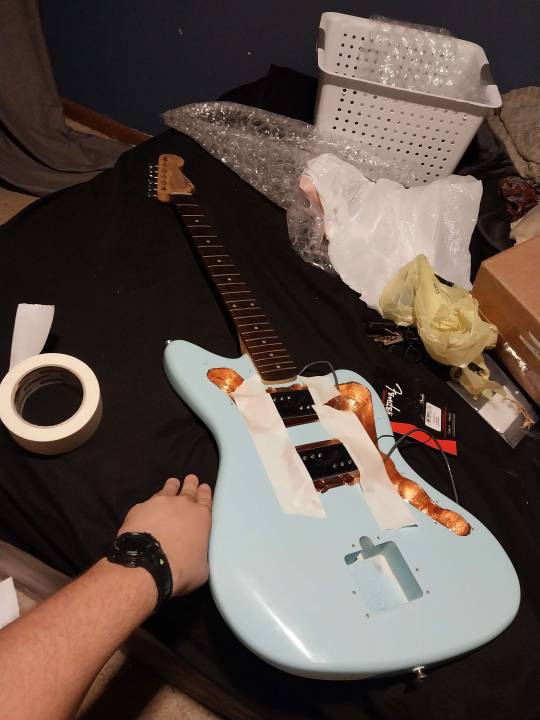
and here have a more up to date pic of my jaguar as a bonus.

7 notes
·
View notes
Text
Build #3 — Polaris

First proper go at custom inlays, and the finish is a custom color firestorm effect that I think I've perfected. The guy that did the finishes for fender in the 90s hasn't responded to my emails so I had to reverse engineer it. A huge step forward in my lutherie abilities.
Specs: Vaguely precision bass inspired body, reverse custom headstock, Seymour Duncan musicman pickups, milspec tefzel wiring, magnetic cavity covers, swamp kauri and maple neck, custom inlays, hipshot hardware, Grainger Guitar parts ferrule block and theaded inserts for the neck. All in all, fucking insane. But it works, somehow, in the end. This has already been up on stage multiple times, it's such an honor to make something so integral for a gigging musician! 🤘 (Also the owner happens to be my brother, so it's nice to know I made something he likes and treasures.)






4 notes
·
View notes